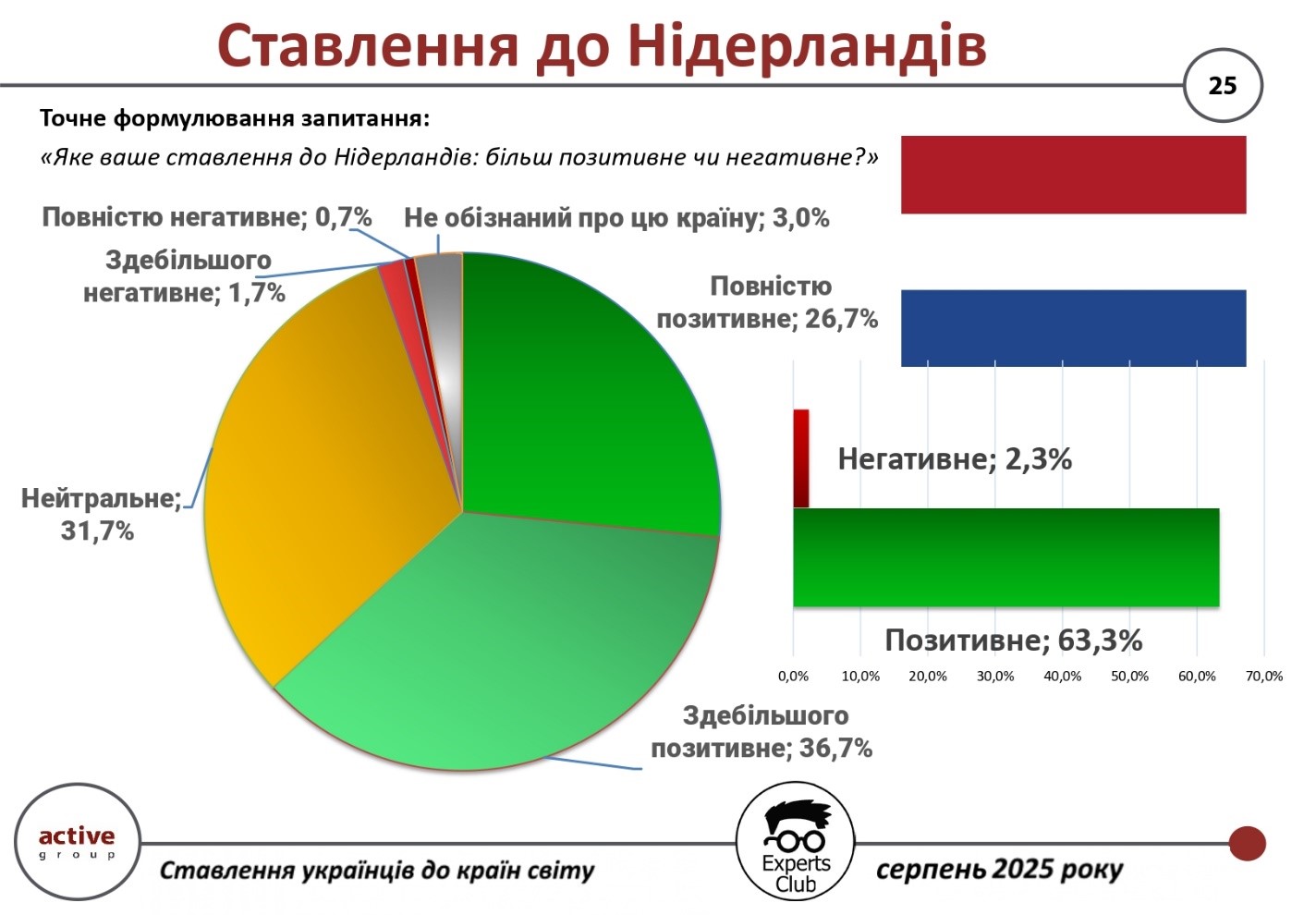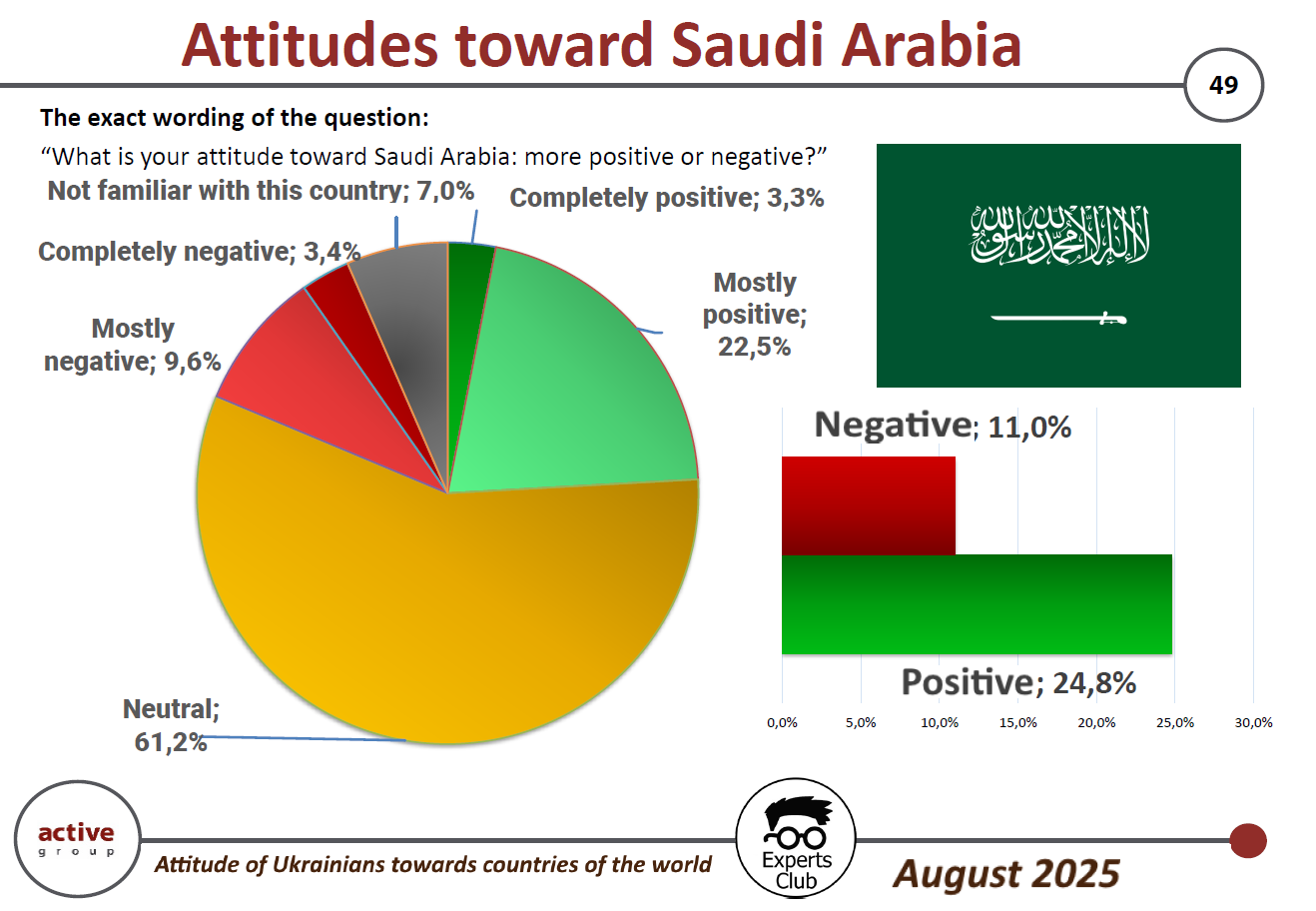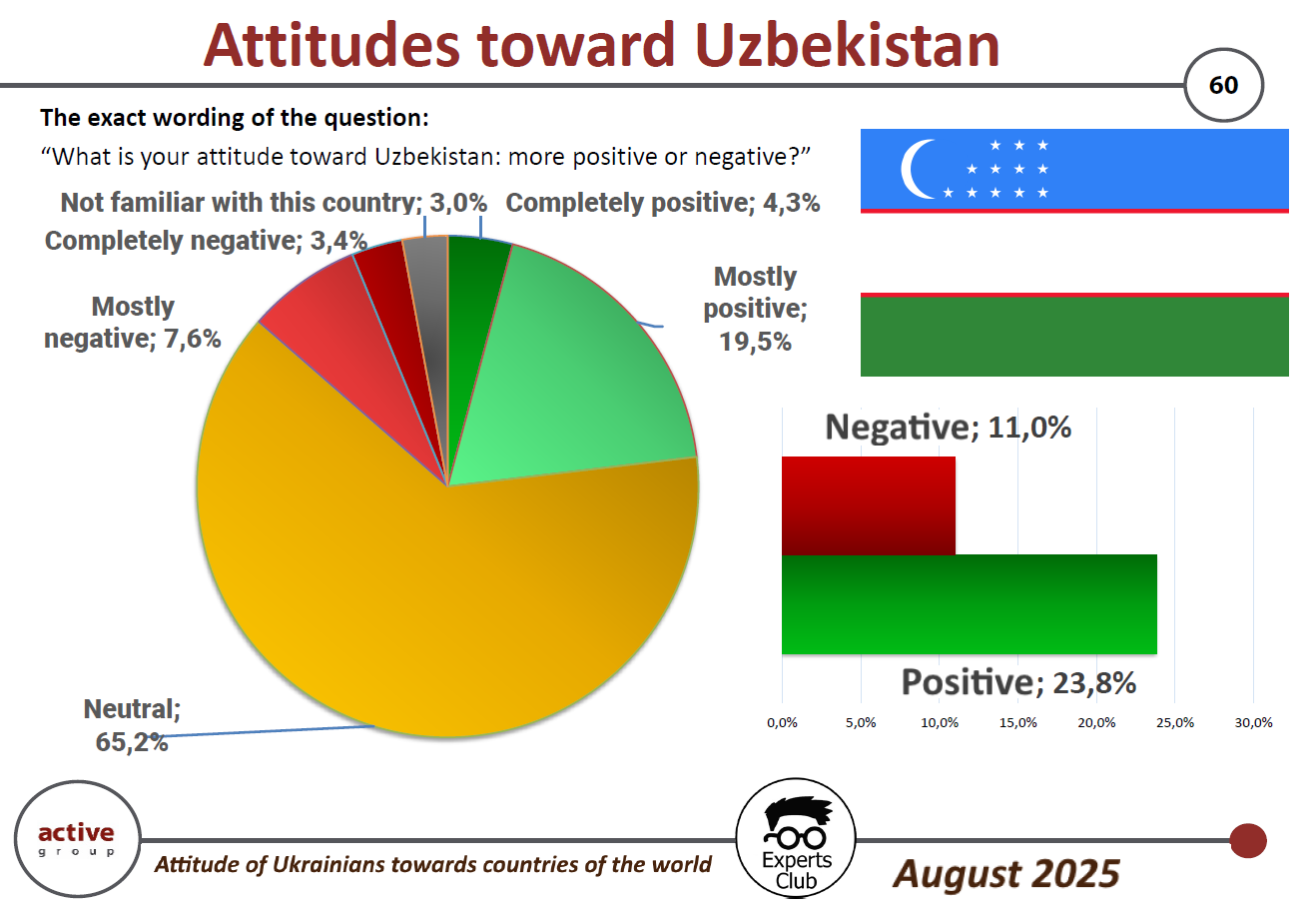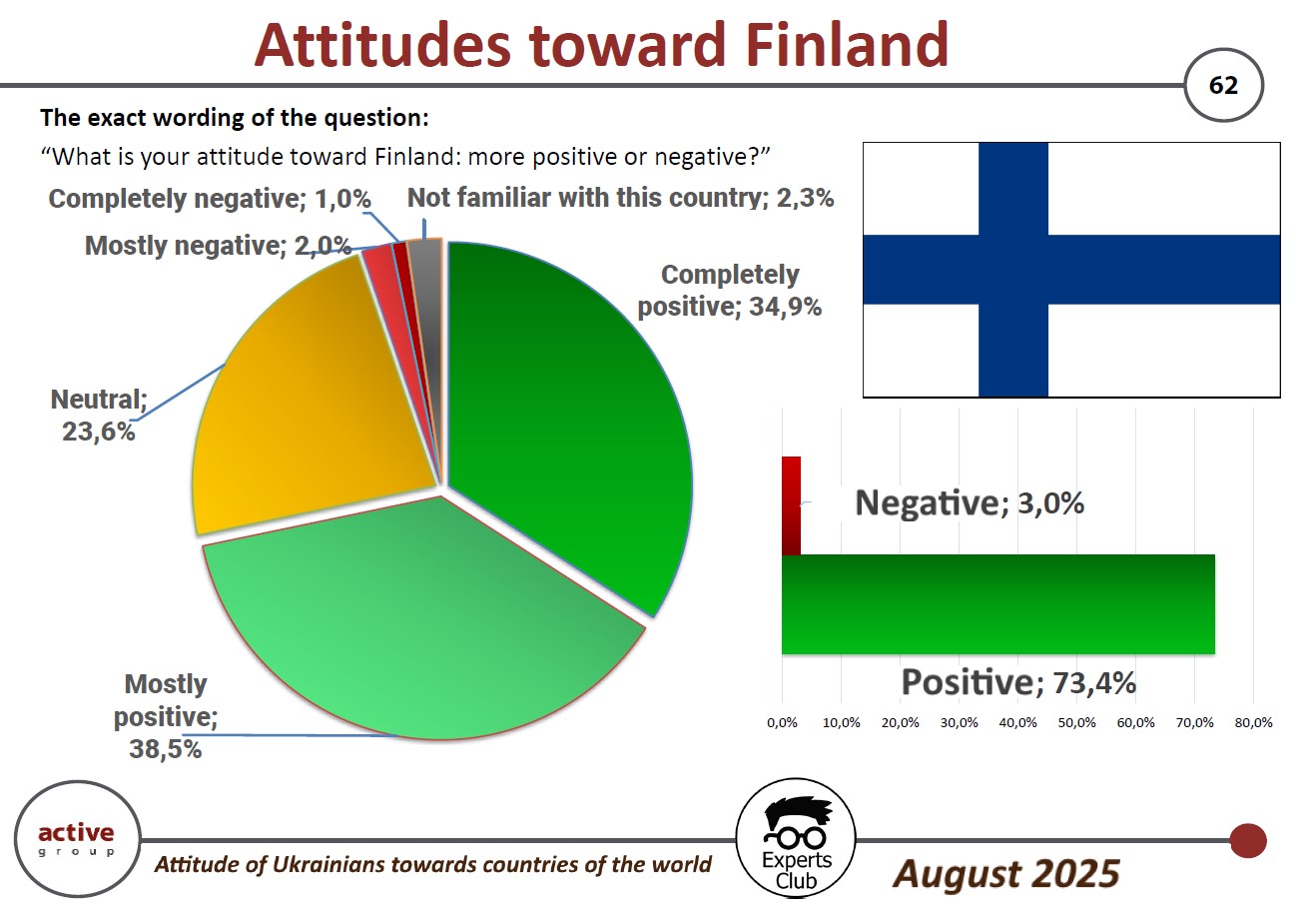

The Netherlands ranks high in the rating of Ukrainians’ sympathies, demonstrating a consistently positive image among citizens. This is evidenced by the results of an all-Ukrainian survey conducted by Active Group in cooperation with the Experts Club information and analytical center in August 2025.
According to the study, 63.3% of Ukrainians have a positive attitude towards the Netherlands (36.7% – mostly positive, 26.7% – completely positive). Only 2.3% of respondents expressed a negative attitude (1.7% – mostly negative, 0.7% – completely negative). Another 31.7% of citizens are neutral, and 3.0% said they are not sufficiently aware of this country.
“The Netherlands is one of Ukraine’s most important trading partners in the European Union. In the first half of 2025, the volume of bilateral trade amounted to almost $ 1.48 billion, of which exports from Ukraine amounted to more than $ 918 million and imports from the Netherlands – $ 561 million. The positive balance of $357 million is evidence that Ukraine has favorable positions in cooperation with this country,” said Maksym Urakin, founder of Experts Club.
In his turn, Alexander Poznyi, co-founder of Active Group, emphasized that the positive attitude of Ukrainians is complex.
“The Netherlands is known as a country that supports Ukraine in the international arena and participates in humanitarian and financial assistance programs. At the same time, long-term cultural and educational contacts strengthen the positive image of this country in Ukrainian society. That is why almost two-thirds of citizens show favorable attitudes, and the negative segment remains minimal,” he added.
The survey was part of a broader study of international sympathies and antipathies of Ukrainians in the current geopolitical environment.
The full video can be viewed here:
https://www.youtube.com/watch?v=YgC9TPnMoMI&t
You can subscribe to the Experts Club YouTube channel here:
https://www.youtube.com/@ExpertsClub
ACTIVE GROUP, DIPLOMACY, EXPERTS CLUB, NETHERLANDS, Poznyi, SOCIOLOGY, TRADE, URAKIN


Lithuania remains one of the most positively perceived countries among Ukrainian citizens. This is evidenced by the results of an all-Ukrainian sociological survey conducted by Active Group in cooperation with the Experts Club information and analytical center in August 2025.
According to the survey, 71.7% of Ukrainian citizens have a positive attitude towards Lithuania (34.0% – mostly positive, 37.7% – completely positive). Only 3.3% of respondents expressed a negative attitude (2.3% – mostly negative, 1.0% – completely negative). At the same time, 23.0% of Ukrainians remain neutral, and 2.3% admitted that they do not have enough information about this country.
“For Ukrainians, Lithuania is a symbol of true friendship and unconditional support. The high level of positive assessments is the result of active political, military and humanitarian assistance from Vilnius during the war,” said Oleksandr Poznyi, co-founder of Active Group.
In turn, Maksym Urakin, founder of Experts Club, emphasized the economic component of relations between the two countries:
“In the first half of 2025, trade between Ukraine and Lithuania exceeded $988 million. At the same time, Ukrainian exports amounted to almost $348 million, while imports from Lithuania reached more than $640 million. The negative balance of about $293 million indicates Ukraine’s dependence on Lithuanian supplies,” he emphasized.
The survey was part of a broader program of research on international sympathies and antipathies of Ukrainians in the context of modern geopolitics.
The full video can be viewed here:
https://www.youtube.com/watch?v=YgC9TPnMoMI&t
You can subscribe to the Experts Club YouTube channel here:
https://www.youtube.com/@ExpertsClub
ACTIVE GROUP, DIPLOMACY, EXPERTS CLUB, LITHUANIA, Poznyi, SOCIOLOGY, TRADE, URAKIN

According to the results of a study conducted by Active Group and Experts Club in August 2025, Ukrainians express a predominantly neutral or moderately positive attitude toward Saudi Arabia.
According to the survey, 61.2% of respondents have a neutral attitude toward this country. A positive assessment was given by 24.8% of respondents (3.3% — completely positive, 22.5% — mostly positive). A negative attitude was expressed by 11.0% of Ukrainians (3.4% — completely negative, 9.6% — mostly negative), while 7.0% admitted that they were not familiar enough with the country.

“Saudi Arabia is perceived by Ukrainians as a distant and little-known partner. At the same time, the positive assessment of more than a quarter of respondents indicates interest in cooperation and openness to the development of relations,” commented Active Group Director Oleksandr Pozniy.
Experts Club co-founder Maksym Urakyn emphasized the economic aspect:
“In 2025, trade turnover between Ukraine and Saudi Arabia reached $287.2 million. At the same time, exports from Ukraine amounted to $207.8 million, while imports amounted to only $79.4 million, resulting in a positive balance of $128.4 million. This is one of the most balanced areas for Ukraine, especially in the field of agricultural products,” he said.
The survey was part of a large-scale project by Active Group and Experts Club to study Ukrainians’ attitudes toward countries around the world.
ACTIVE GROUP, EXPERTS CLUB, international relations, Pozniy, SAUDI ARABIA, SOCIOLOGY, TRADE, UKRAINE, УРАКИН


The attitude of Ukrainians towards Romania is predominantly positive, although a significant proportion of respondents are neutral. This is evidenced by the results of an all-Ukrainian survey conducted by Active Group in cooperation with the Experts Club information and analytical center in August 2025.
According to the survey, 46.3% of Ukrainians have a positive attitude towards Romania (33.7% – mostly positive, 12.7% – completely positive). A negative attitude was expressed by 7.0% of respondents (6.0% – mostly negative, 1.0% – completely negative). Another 44.3% of citizens are neutral, and 2.7% admitted that they do not know enough about this country.
“For Ukraine, Romania is not only a neighbor and a member of the EU and NATO, but also an important trading partner. In the first half of 2025, the volume of bilateral trade exceeded $1.49 billion, of which exports from Ukraine amounted to more than $679 million and imports from Romania – almost $820 million. The negative balance of $140 million indicates that economic ties remain active and have the potential for further development,” said Maksym Urakin, founder of Experts Club.
In his turn, Oleksandr Poznyi, co-founder of Active Group, noted that the sociological results demonstrate stability in public perception.
“More than a third of Ukrainians rate Romania positively, and almost half are neutral. This means that the negative segment remains relatively small, and thus Romania is viewed by Ukrainians as a neighbor with whom they can maintain constructive relations,” he added.
The survey is part of a broader study of international sympathies and antipathies of Ukrainians in the current geopolitical environment.
The full video can be viewed here:
https://www.youtube.com/watch?v=YgC9TPnMoMI&t
You can subscribe to the Experts Club YouTube channel here:
https://www.youtube.com/@ExpertsClub
ACTIVE GROUP, DIPLOMACY, EXPERTS CLUB, Posniy, ROMANIA, SOCIOLOGY, TRADE, URAKIN

Most Ukrainians express a neutral attitude toward Uzbekistan. This is evidenced by the results of a survey conducted by Active Group in collaboration with Experts Club in August 2025.
According to the results, 65.2% of respondents said they had a neutral attitude towards the country. 23.8% of Ukrainians have a positive attitude (4.3% — completely positive, 19.5% — mostly positive). A negative attitude was expressed by 11.0% of respondents (3.4% — completely negative, 7.6% — mostly negative), while another 3.0% admitted that they were almost unfamiliar with this country.

“Ukrainians do not yet have a clearly formed opinion about Uzbekistan. This is due to the country’s low level of information presence in the Ukrainian media space. The neutral position of the majority leaves room for the development of both political and economic relations,” explained Active Group Director Oleksandr Pozniy.
Experts Club co-founder Maksym Urakyn emphasized the economic aspect:
“In 2025, trade turnover between Ukraine and Uzbekistan reached $165 million. Ukraine exported goods worth $95.4 million, while imports amounted to $69.6 million, resulting in a positive balance of $25.8 million. This indicates the potential for expanding cooperation, particularly in the agro-industrial sector and mechanical engineering,” he said.
The survey was part of a large-scale study by Active Group and Experts Club on Ukrainians’ attitudes toward different countries around the world.
ACTIVE GROUP, EXPERTS CLUB, international relations, Pozniy, SOCIOLOGY, TRADE, UKRAINE, URAKIN, UZBEKISTAN

Most Ukrainians have a positive attitude toward Finland, according to the results of a sociological survey conducted by Active Group in collaboration with Experts Club in August 2025.
According to the published data, 73.4% of respondents have a positive attitude towards this country: 34.9% — completely positive, 38.5% — mostly positive. Only 3.0% of Ukrainians have a negative attitude (1.0% completely negative, 2.0% mostly negative). At the same time, 23.6% of citizens took a neutral position, and another 2.3% admitted that they were not familiar enough with Finland.
“The high level of positive attitudes toward Finland can be explained by both Ukraine’s support at the political level and assistance in the areas of defense, education, and humanitarian projects. Finland has long been perceived by Ukrainians as part of the European family and an ally in countering Russian aggression,” commented Active Group CEO Oleksandr Pozniy.

Experts Club co-founder Maksym Urakyn drew attention to economic indicators:
“In 2025, trade turnover between Ukraine and Finland amounted to more than $163.6 million. Exports from Ukraine amounted to only $21.6 million, while imports exceeded $141.9 million. The negative balance of $120.4 million indicates significant potential for export diversification, particularly in the fields of woodworking, agricultural products, and mechanical engineering,” he emphasized.
The study is part of a large-scale project by Active Group and Experts Club to analyze Ukrainians’ international sympathies and the prospects for foreign economic relations.
ACTIVE GROUP, EXPERTS CLUB, FINLAND, Pozniy, RELATIONS, SOCIOLOGY, TRADE, UKRAINE, URAKIN